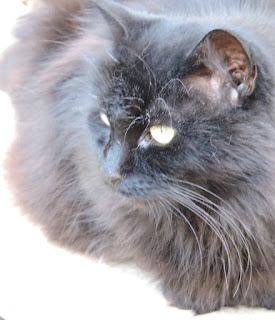Winnie couldn't be more different from the previous Winnie we had here - a little tabby/siamese cross that wanted nothing more than to love the humans who cared for her. This Winnie excels as a Garbo cat - “I vant to be alone.” In her cage she rumbled and grumbled; once released she made a point of finding places that would not be invaded by other cats. Winnie is a large lady, but finding those islands of safety often meant climbing up on top of the can-cupboard outside the SingleWide – not a easy climb for a not-very-athletic cat!
Once out and about, she was cautiously tolerant of humans – too much attention and she had no problem telling you where to get off. But other cats – no! Winnie was Queen in her own little world, and didn’t want invaders. I often found it funny that she shared space with the other extreme loner, Leland – he on his chair on the left of the porch and she in her basket on the right – both carefully not looking at the other.
Through the summer months, Winnie has mellowed somewhat; she ventures down into the courtyard for some sunning, and is ready to interact with visitors and volunteers. With the people she trusts the attention span is longer, but woe betide the cat that ventures into her orbit!
As far as we know, she’s not a pee-er; she’s just a cat that would have to be an “only” in a home situation, and with a human with whom she is comfortable. But when you have the double whammy of being large and black, and a bit grumpy, it can be hard to find a home. She wouldn’t be able to handle being at the Shelter, so the Sanctuary is her home, unless someone falls in love with her, and can live with her little quirks.
Blog by Brigid Coult
All photos by Michele Wright




































